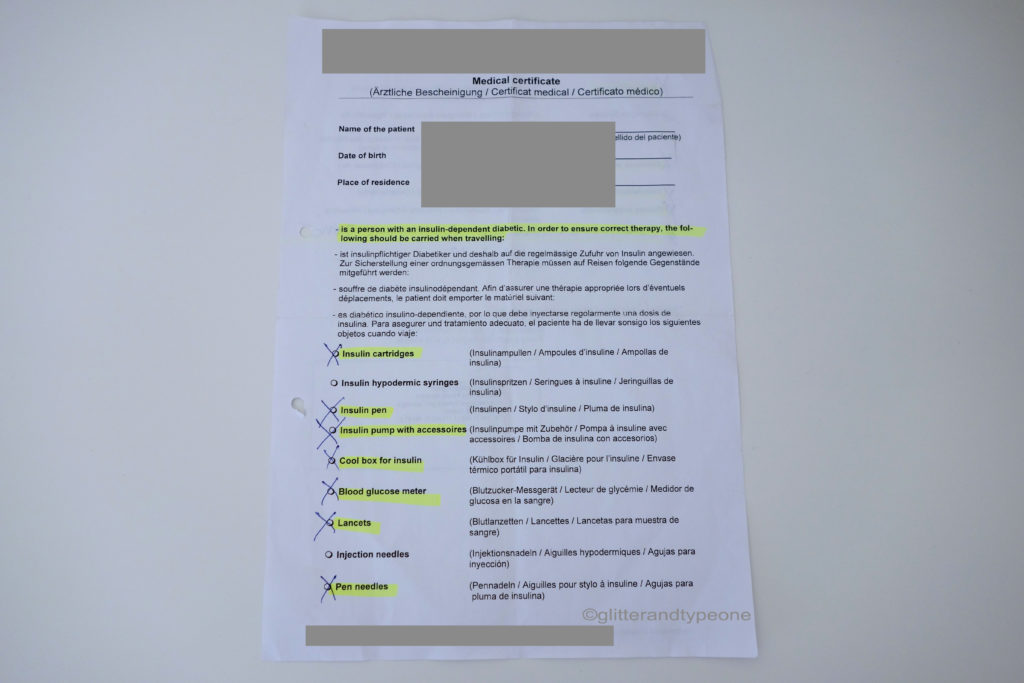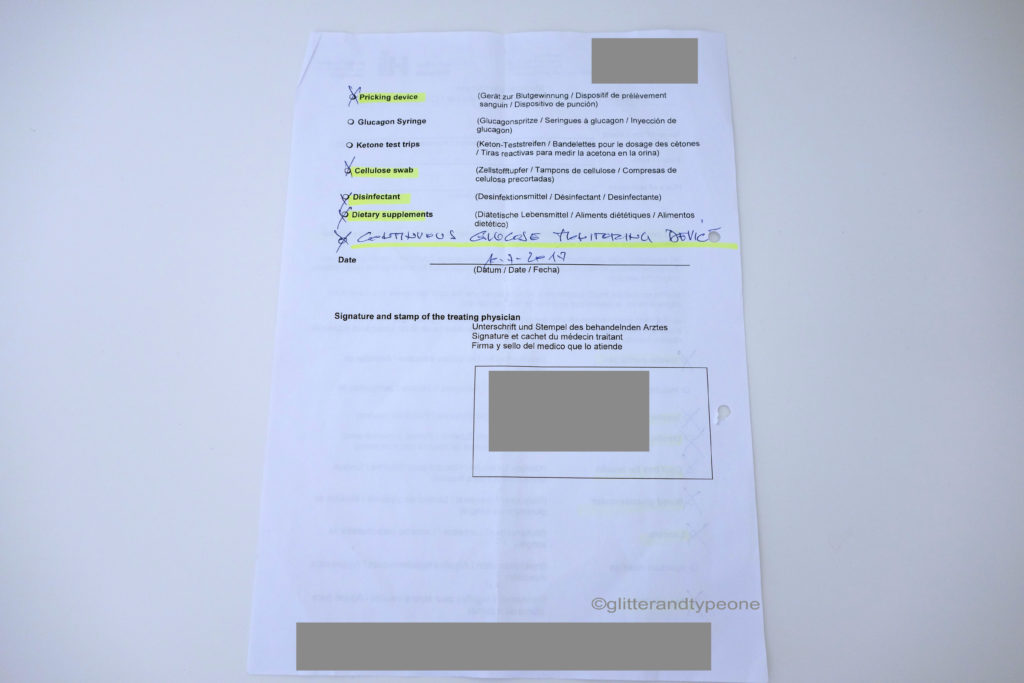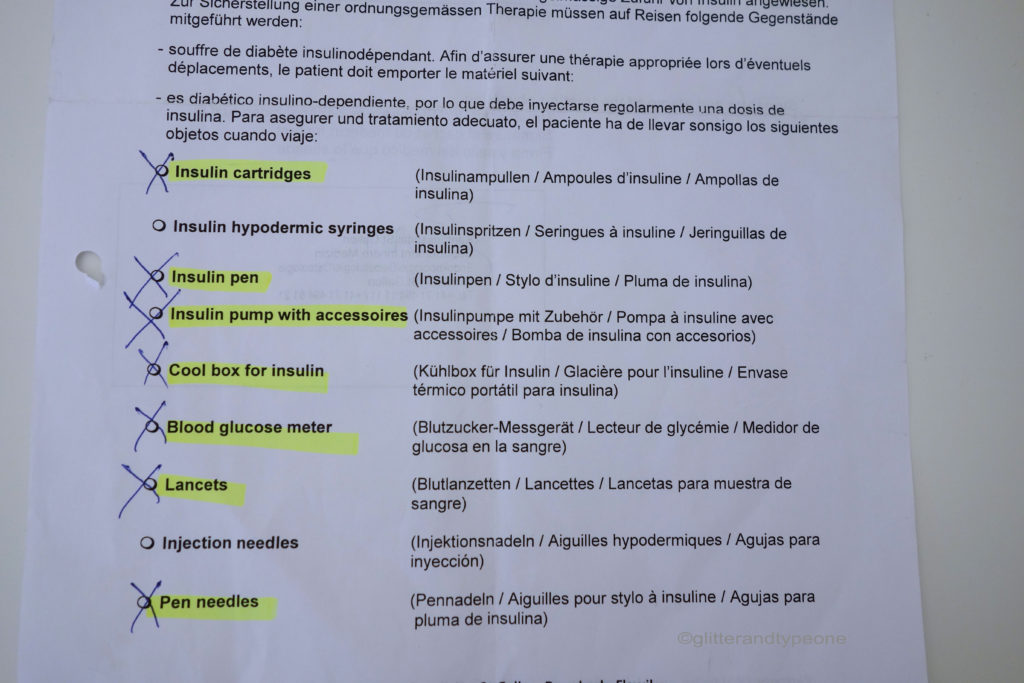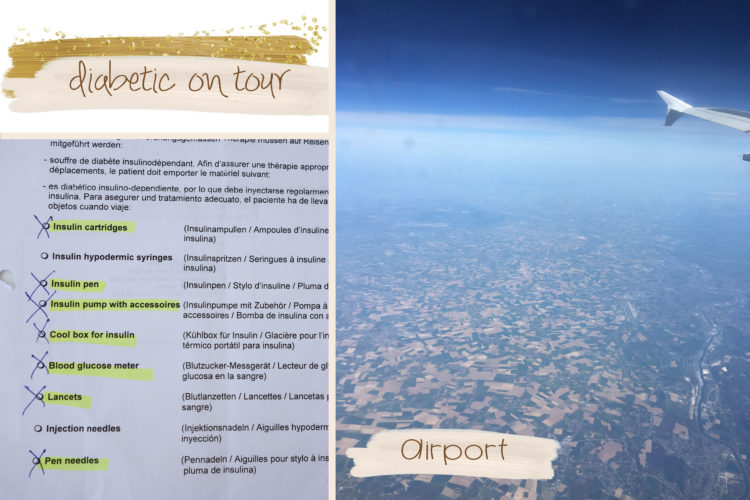Welcome back to „diabetic on tour“. Last time we talked about packing with Diabetes, today we’ll tackle the Airport. Dos and don’ts so that you actually make it to your destination.
Going on a vacation is always exciting and stressful at the same time (at least for me). I love to explore new cities but I’m always a nervous wreck when it comes to traveling. Don’t get me wrong: I actually enjoy flying, it’s the security at the airport that gets me nervous especially since I worry about all my diabetes stuff. But have no fear, I’m here to share my dos and don’ts when it comes to tackling the airport when you’re traveling with your diabetes supplies.
Do pack right
I wrote a whole post about it here. Go and read it, it should clear up any questions you have about packing. Don’t forget to bring everything in your carry on or your medical bag if that is allowed.
Don’t run out of time at the airport
If you know me you are familiar with the fact that I am always on time. Better yet: I show up too early. This comes in handy when you’re traveling with diabetes. Checking in your bag, going through security and walking to your gate can take some time for everyone. As a diabetic you’re most likely going to need more time at security. Factor that into your planning. For international flights I try to be at the airport 3 hours before my flight takes off. If I’m flying within Europe 1.5 hours is enough. You don’t wanna miss your flight because security took longer and you’re experiencing a low on the way to the gate and have to take a break.
Do bring a medical certificate
My hospital has a medical certificate that you can get filled out when you are traveling by plane. It lists all the things you’re allowed to bring with you and gets signed by the doctor.


(I blocked out some things due to privacy reasons: my full name and address, my hospital and the doctors signature)
I always get a new one when I’m going on a trip. As soon as I get to the security check I take out my normal liquids and my insulin and I present the certificate to the agent.

Mine is in four languages (English, German, French, Italian) which makes it even easier to understand for foreign security agents. Some agents will look at it, others will ignore it. But it’s always good to have it on hand. It has allowed me to bring a little iced-tea on the plane that was bigger than the 100mls allowed. Depending on which airport you’re flying out of, you won’t have any problems (for example Zurich, Boston, Dublin) others will make it a little more complicated (like London Heathrow).
Do opt out – know your rights
This one is important if you’re traveling to or within the US. They have full body scanners and although they tell you it won’t harm your pump I’d advise you to opt out. If you’re next in line just tell them “I’m opting out“. They will ask you why and some try to get you to walk through there regardless. Don’t give in and opt out. The radiation could harm your pump and nobody wants a broken pump. This only goes for full body scanners. You can walk through normal scanners without a problem.
As soon as you’re opting out they will tell you to wait for an agent. As a female they need to get a female agent to pat you down so that means it can take some time (as most TSA agents are male). They will aks you if you want to go to a private room or if you are comfortable with getting the pat down done at the security check. I decided to stay at the check because my luggage and my friend where there. You have to stand with your feet and arms spread out and the palms of your hands facing the ceiling. The agent asked me where my pump was and began the pat down. She always told me what she is going to do and I didn’t feel uncomfortable at all. In the end you have to rub your pump between the palms of your hands and they’ll test them for any explosive. After that you are done. I was really nervous the first time around but it wasn’t as scary as I thought.
You should take this extra step of a pat down into account when planning/calculating your time slots.
Don’t panic and stress if something goes wrong
I mentioned above that some airports are easier to deal with and some are a bi***. I’m not the only diabetic that had trouble at London Heathrow for example. They were very rude to me and they took away my sugary drink despite the medical certificate. I tried to explain why I need it and they just ignored it. Now that was when I went on my first trip since being diagnosed. As you can imagine, I was a wreck. That little thing threw me off so much that I stared crying once we left the security (where the took my coke). Thank good I had one of my close friends with me who calmed me down and bought me a new coke at the next kiosk we could find. In hindsight it all worked out but in the moment, that was the end of the world for me.
Now fast forward to Spring 2018. I was in Dublin with my mum and we were at the airport to fly back to Switzerland. I didn’t bring an Ice-Tea with me but had my dextro. While going through securtiy I started going low. I took some dextrotabs but that didn’t help any. In my haste to get all my diabetes stuff through security I forgot my I-pad in my bag. Naturally they picked it up and my bag had to be searched and put through security again. As I was standing there waiting I felt my sugar drop again. I told my mum that we’ll need to find me an Ice-tea asap. When everything was cleared with my bag I just stuffed it closed and we took off to the next kiosk. I got my Ice-Tea and an extra snack. My blood sugar was so low that I told my mum we need to take a break and I sat down on my carry on in the middle of the airport. I didn’t care that some people looked at me a little weird. When my sugar was back in range we made our way to the gate and I took some time to organise my stuff again.
What I want to tell you with these 2 stories: If something does go wrong try not to freak out und take it step by step. Most of the time it will be okay in the end.
Do pre board
Did you know that you can pre board if you have medical supplies with you? I didn’t but read about it on insta last year and decided to try it out. It worked every single time. I went up to the gate agent and told them about my medical bag and my condition and asked if I could board first and every single time I could.
Now why do you need it? If you are only carrying your carry-on you need to have it somewhere around you. Let’s say you’re one of the last people to board, chances are that the overhead compartment by your seat is stuffed to the brick and your carry-on won’t fit. Having it somewhere else in the plane could lead to dangerous situations should you need it during the flight. Some people also need time to get situated in their seat and place everything in it’s right spot. Pre boarding allows you to just do that. Little extra tip: If you ask nicely they let your travel partner preboard with you.
Don’t loose track of your numbers
Traveling can be stressful for your body and we all know that stress affects your sugars. I used to be fine on the ground, high while in the air and comming down again once the plane landed. Reason for that was that I was very cautious with my insulin because I really didn’t want to go low while in the air. Nowadays I am bolder with insulin while I am on a plane. I bolus just like I normally would and rely on my cgm. It tells me where I am at and alarms me if I am going low or high.
I heard that some diabetics have to disconnect their pump during take off and landing because it delivers insulin due to the pressure change. I never noticed that with my pump but just be aware oft that.
Do bring your own snacks
We all know airplane food can be tricky with carb counting and honestly it’s not always the best tasting. Why not bring your own snack? That way you know the carb count and you actually have something tasty to eat. On my flight to Chicago I brought my own dinner (sandwich), snack and even breakfast (Scone). That way I knew how much insulin I needed to give myself and I was in range for most of the flight.
I hope this helps you with your experience at the airport when traveling with diabetes. The next post in this series will be an interview with a travel partner.

